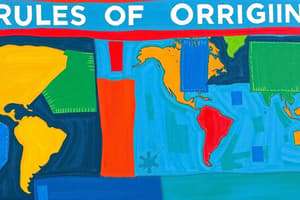Podcast
Questions and Answers
What is a major problem with the application of the Change or Shift in Tariff Classification criterion?
What is a major problem with the application of the Change or Shift in Tariff Classification criterion?
- Difficulty in determining specific changes in tariffs classification that guarantee substantial transformation (correct)
- Classifying merchandise in terms of other criteria
- Determining the minimum requirement for changes in tariff classification
- Determining the National Value Added
What is the basis for the Preferential Rules of Origin System used by certain organisations?
What is the basis for the Preferential Rules of Origin System used by certain organisations?
- National Value Added
- HS Code (correct)
- Change in Tariff Heading
- Tariff Classification
What is National or Regional Value Added defined as?
What is National or Regional Value Added defined as?
- The minimum value that must be added during intraregional processing
- The maximum level of components from third countries a good can have (correct)
- The minimum level of components from third countries a good can have
- The maximum value that must be added during intraregional processing
What determines the production costs of a country?
What determines the production costs of a country?
What is a shortcoming of the National or Regional Value Added criterion?
What is a shortcoming of the National or Regional Value Added criterion?
What is the main purpose of the Harmonised Commodity Coding and Classification System (HS Code)?
What is the main purpose of the Harmonised Commodity Coding and Classification System (HS Code)?
What is the Change or Shift in Tariff Classification criterion used for?
What is the Change or Shift in Tariff Classification criterion used for?
What is a characteristic of the National or Regional Value Added criterion?
What is a characteristic of the National or Regional Value Added criterion?
What is the purpose of determining the Origin of goods?
What is the purpose of determining the Origin of goods?
What is the relationship between the HS Code and the Change or Shift in Tariff Classification criterion?
What is the relationship between the HS Code and the Change or Shift in Tariff Classification criterion?
Flashcards are hidden until you start studying
Study Notes
International Trade Policy and Law Chapter 3: RoO
- Regional trade agreements are a characteristic trend in the current phase of economic globalization.
Economic Integration
- Economic integration is taking place within a framework of open regionalism following liberalization and economic reforms in the developing world.
- The prevailing model for economic integration in the Western Hemisphere is the creation of Free Trade Agreements (FTAs) with a tendency towards incorporating issues beyond trade in goods, such as investment and government procurement.
Importance of Rules of Origin (RoO)
- RoO are of particular relevance in both theoretical and planning terms for the design of trade and integration policies.
- The creation of regional trade agreements has increased the importance of RoO, especially in the 1990s with the notable increase in trade agreements.
Impact of RoO on Investors
- Investors from regional member countries may favor a true diversion of investment due to RoO.
- Modification of productive processes to comply with origin demands may negatively affect extra-regional companies' efficiency and competitiveness.
- However, RoO can act as an incentive for extra-regional investment in sub-regional economies with potential for economies of scale.
Criteria for Determining RoO
Change or Shift in Tariff Classification
- This involves meeting a minimum requirement for changes in tariff classification between a finished good and foreign components or materials used in the production process.
- A change in tariff heading that is in the first four digits of the tariff classification determined by the Harmonised Commodity Coding and Classification System (HS Code) is the basis for the Preferential Rules of Origin System.
Criticisms of the Tariff Classification Criterion
- It is difficult to determine specific changes in tariffs classification that guarantee equivalent substantial transformation in the production of all goods covered by tariffs.
- The HS was designed not to serve as the sole instrument for determining the origin of goods but rather to be used in classifying merchandise in terms of other criteria.
National or Regional Value Added
- This criterion defines the maximum level of components and raw materials from third countries a good can have and still be considered as originating inside the integrated area.
- Alternatively, it defines the minimum value that must be added during intraregional processing for the good to qualify as originating in the FTA.
- This criterion suffers from shortcomings, including being highly sensitive to changes in factors that determine countries' production costs, such as exchange rates, inflation rates, interest rates, commodity prices, wages, and workers' benefits.
Studying That Suits You
Use AI to generate personalized quizzes and flashcards to suit your learning preferences.




